How to repair the Agidel pump: an overview of typical breakdowns and how to fix them
Agidel are compact and reliable pumps, popular among summer residents and owners of country households.They successfully pump water from quite a decent depth. But, like any equipment, they also have breakdowns. Agree, it would be nice to handle the repairs yourself, without resorting to the services of specialists.
What to do if the pump does not pump water? It turns out that in the event of a breakdown, repairing the Agidel pump yourself is not so difficult. It is enough to know its structure, operating principle and operating features.
We will tell you about the most common problems with popular equipment and the reasons for their occurrence. The article collects and summarizes expert advice, provides work diagrams, as well as useful photos and videos that will help you deal with the problem.
The content of the article:
Models and operating features
“Agidel-M” and “Agidel 10” are surface type models produced by Ufa PO. Relatively high performance at a very affordable price, compact size, high maintainability - all this has made the Agidel pump popular and in demand in Russia and neighboring countries.
The Agidel-M model is purchased even by those owners of private houses who use the services of a central water supply. In such cases it serves as a stabilizer system pressure.
This small device weighs only 6 kg and its power is also relatively low - only 370 W. The hose can be immersed to a depth of up to 7 m, but if you use an ejector, this figure will increase to 15 meters.
With proper operation of such a pump, you can achieve a water pressure of about 20 m, which is quite enough to perform many operations, for example, for irrigation or pumping water out of various containers. The power of “Agidel 10” is higher - 500 kW. He is three kilograms heavier, weighing 9 kg.

“Agidel 10” provides a pressure of up to 30 m. This is quite enough to not only pump out water from their well, but also organize autonomous water supply at home or cottages with quite comfortable working pressure in the system. A useful feature of Agidel pumps is their fairly long operating time.
The engine of the device is equipped with an effective cooling system, so it does not overheat during operation. However, these devices are demanding in terms of operating conditions. Using Agidel pumps in the right conditions can reduce the number of breakdowns or avoid them altogether.
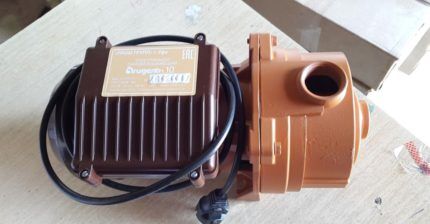
Pumps of this type are designed to pump clean water without contaminants and with a temperature of no more than 35 degrees. Before starting operation, you should carefully study all technical documentation of the device, taking into account the features of a particular model.
Both modifications “Agidel 10” and “Agidel M” require preliminary preparation. The pumping parts of the devices must first be filled with water so as not to burn out the mechanical seal.
Both pump models should be installed on a flat, horizontal and solid surface. The pump can operate under other conditions, but its efficiency is noticeably reduced. It is important to maintain all distances correctly.
For example, if water is drawn from a container or some reservoir, at least 350 mm of free space must remain from the bottom of this object to the inlet valve of the hose connected to the pump.
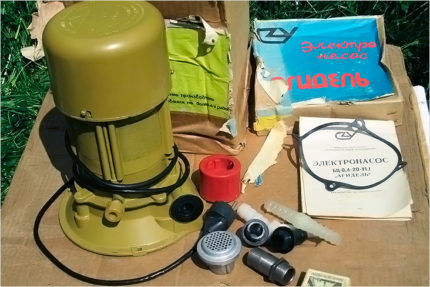
The closer the pump is to the water source, the higher its efficiency. Therefore, “Agidel” is almost never put in the house.
The device located outside residential buildings should be protected from precipitation and direct sunlight, the effects of which can overheat even when the unit is turned off. For protection, a durable box that you can make yourself is suitable.
This is a suitable option for a summer house where the pump is used only for summer time. This device is not intended for use in cold weather. What to do if you need to use “Agidel” all year round?
The most labor-intensive solution to the problem looks like this: you need to dig a pit deep enough to install a pump in it below the freezing level of the soil.
Sometimes owners decide to install “Agidel” in the house, having come to terms with some loss in the efficiency of its operation. Or you can place a separate heated room near the water source.
This method may not be the most complicated, but it is certainly the most expensive both to implement and to operate.
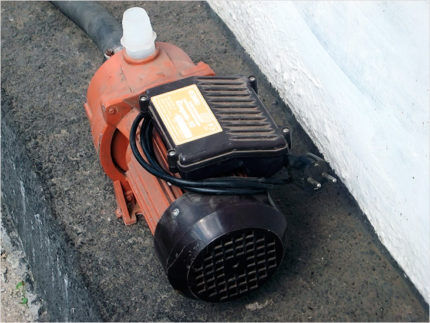
If the home owners have a sufficiently spacious well at their disposal, the pump can be installed directly in it. This way it will be significantly below the soil freezing level and will be reliably protected from the cold.
Installation site pump Agidel A special raft of compact dimensions or brackets fixed below the depth of seasonal freezing of the soil are used. The proximity of the device to the source has an extremely positive effect on the efficiency of the pump.
It is necessary to place the device on the raft very carefully, since the risk of contact of the device body with water increases. This is extremely undesirable, because this is a surface and not a submersible model. This solution will cause another problem - lack of length of the electrical cable.
The cable of such pumps is very short - only one and a half meters. Most likely, you will have to extend the cable, carefully insulating the joints with heat-shrinkable sleeves.
The use of household extension cords inside a well is highly undesirable, since even with slight contact of the connection with water, a short circuit is almost guaranteed.
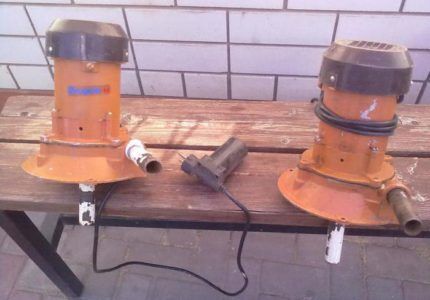
An excellent way to break the Agidel at the very beginning of its operation is to turn it on without filling it with water. For these units, “dry running” is strictly contraindicated. As a result, the cuffs will deteriorate and lose their tightness, water will get into the engine, and it will burn out.
The damage can be eliminated only by completely replacing it, and such a case does not fall under the terms of the warranty.
To fill the Agidel modifications with water before starting operation, you will need a 1.5 liter container of water and a funnel with a thread required to screw it into the filler valve. After 4 - 5 minutes. After filling, the device can begin pumping water. Before filling, it should be taken into account that the engine of the device immediately fails when water gets on it.
Causes of the most common breakdowns
If problems arise with the operation of the Agidel pump, first of all, you should check its operating conditions. There have been cases when simply changing the position of the pump, for example, installing it on a more reliable base, made it possible to significantly correct the situation.
Problems with the electrical cable or pump motor were previously mentioned. Such problems are extremely rare if the device is used correctly.
There are not so many reasons for breakdowns when the Agidel pump for some reason does not pump water. Among the most common, it is worth noting an incorrectly selected hose or a leaky seal. In both cases, the damaged element must be replaced. Before starting this procedure, especially if we are talking about the oil seal, you will have to carefully study the design of the pump.
How to repair “Agidel M”
As mentioned above, there are not so many reasons for the breakdown of the Agidel pump. We will look at the two most common ones and tell you how to deal with them.
Breakdown #1. The water stopped flowing
If water flows unevenly from the pump, jerkily, or stops flowing altogether, but the pump turns on and hums, there is most likely a problem with the hose. If such signs appear, it is best to turn off the pump immediately to prevent operation in “dry running” mode. It is especially important to do this if we are talking about the “Agidel M” model.
Problems usually arise when using a regular rubber hose. This happens as follows. As the pump operates, a rarefied environment is created inside the hose cavity, and the pressure decreases.
A regular hose is not designed to withstand such loads. Its walls are deformed, reducing the clearance inside the hose, or completely collapse.
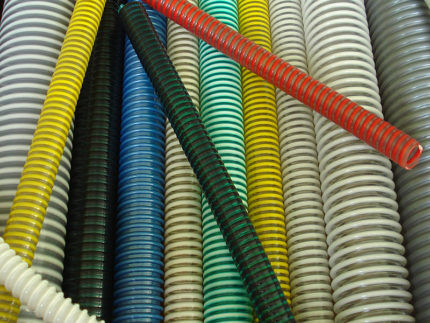
As a result, water flows into the system in jerks or stops flowing altogether. It's not difficult to correct the situation. To do this you should:
- Disconnect the pump from the power supply.
- Remove it from the protective box.
- Remove the old hose.
- Connect a new hose with suitable specifications.
- If necessary, fill the device with water (if we are talking about the Agidel M model).
- Install the pump in its original place.
- Connect it to the power supply and turn it on.
Usually, after replacing the hose, water enters the system evenly and with good pressure. To prevent the hose from collapsing, it is recommended to use a special material reinforced with a plastic spiral. This hose is extremely resistant to external influences and never collapses.
A plastic water pipe can be an effective alternative to a reinforced hose. If it is more convenient, you can omit just such a construction into the source.
Breakdown #2. The oil seal is worn out
More complex problems arise when the seal in the Agidel pump wears out, i.e. a special seal that is installed on the engine shaft in the place where the water pump is attached to it.
To make a replacement, the pump will have to be almost completely disassembled. Problems with the seal are indicated by leakage from the drain hole of the device. Pumps of this type are disassembled following approximately the following diagram:
- On the top of the case you should find three mounting bolts and unscrew them.
- After the bolts are removed, the casing must be removed from the device.
- Then you need to unscrew four more mounting bolts that hold the electric motor.
- After this, carefully remove the motor housing.
- Now access to the pump volute is freed, which also needs to be removed.
- To do this, unscrew four more mounting bolts.
- There is a rubber gasket under the impeller that needs to be removed.
- Now you should unscrew the nut that secures the impeller.
- The armature axis is removed from the impeller.
- The bearing and armature are removed from the housing.
- After this, you should carefully remove the first oil seal from the impeller, then the plastic separator, then the second oil seal.
- Now, instead of the old seals, you need to take new ones and assemble the entire device in the reverse order.
Even from this brief description it is clear that disassembling and reassembling the Agidel pump requires care and scrupulousness. You need to prepare a place for all the elements in advance.
To facilitate reassembly, it makes sense to lay out the parts not haphazardly, but in the correct sequence. The device includes a variety of mounting bolts. It is best to provide separate boxes for them so as not to lose or mix up anything.
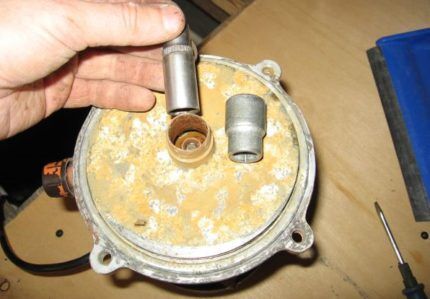
In practice, it is not at all easy to disassemble “Agidel” correctly. If handled improperly, the device can be seriously damaged. More serious repairs and specialist intervention will be required. You should start with proper preparation. So, before you start disassembling the pump, you should purchase the necessary parts, i.e. oil seals.
It is not difficult to buy them, they are not a scarce element, it is recommended to take two oil seals at once and replace both, although there is no rule prohibiting replacing only one.
However, practice shows that if one oil seal wears out, the second one will soon suffer the same fate. In order to avoid assembling and disassembling again, it is easier to immediately change both seals.

Experienced professionals recommend stocking up not with two oil seals, but with a set of 4, 6 or 8 elements. The oil seal not only needs to be installed in place, it must be pressed into place. If handled carelessly, this part can easily be damaged.
In order not to go to the market for a new oil seal, it is better to create a small supply, especially since these elements are not that expensive.
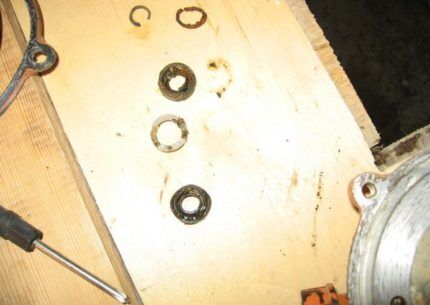
To unscrew the mounting bolts, it is very convenient to use a special socket head of a suitable size. The bolts are standard 13. If the pump was operated correctly, it was cleaned and lubricated on time, then there should not be any big problems with unscrewing the bolts.
A socket wrench, called a socket, will also be needed to unscrew the 13 nut that holds the impeller to the electric motor shaft. You need a special compact wrench with a narrow driver, approximately 6 mm. The fact is that access to the nut is somewhat limited; it is located in a narrow recess. A normal sized head simply won't fit there.
Problems may arise when it is necessary to remove the armature axle from the pump impeller. This element fits quite tightly, you will have to make additional, but careful efforts. If, when trying to remove the element simply by hand, it does not move, you will have to knock it out.
To do this, take a metal (iron or brass) rod. The motor housing is mounted on a support in such a way that a metal rod can be attached to the armature axis.After this, the rod is sharply hit with a hammer.
As a result of the impact, both the armature and the bearing will come out of the electric motor housing, which will allow you to easily remove the impeller from the shaft.
If for some reason it is decided to replace only one oil seal, the upper one, it is simply picked out with a suitable tool. But when replacing both seals, they must be carefully knocked out of the housing.
If you have the right size head, you can use it. If such a tool is not found, a drift can simply be cut from a suitable piece of wood.

The knocking out is done carefully to avoid unnecessary deformation of other elements in the pump structure. The plastic element separating the seals requires especially careful handling.
It is unknown for what reasons, but it is very difficult to find the same one on the open market, although oil seals are freely sold in specialized retail outlets. Therefore, experts recommend carefully protecting the separator.
The oil seal for the Agidel-M pump has an outer diameter of 22 mm, and its inner diameter is 10 mm. The height of the element is 7 mm. When installing both oil seals, remember that its spring must be directed towards the impeller. The plastic separator also needs to be installed correctly. It should not block the drainage hole.
To press back the oil seals, you can use a vice, as well as a round and smooth element, the diameter of which corresponds to the diameter of the oil seal. Pressing is performed alternately, i.e.First, the first oil seal is installed, then the separating element is mounted, then the second oil seal is pressed in. Before continuing reassembly, it is recommended to lubricate the armature axis with lithol; this will make installation work easier.
The remaining stages of reassembly are not particularly complex. Once the device is assembled and filled with water, it is recommended to turn it on and make sure that there is no more leakage from the drainage hole. If this is the case, the repair can be considered successful and the device is in working order.
Useful videos on the topic
Video #1. Interesting experience in operating and repairing the Agidel-M pump:
Video #2. Detailed information about preparing the Agidel-M pump for operation:
Video #3. Visual demonstration of the operation of the Agidel 10 pump:
Most often, when operating the Agidel pump, it is the oil seal that causes trouble for the owners of the device. Overall this is a reliable device. With proper maintenance and regular care, such a pump can reliably last for several decades.
We are waiting for your stories about restoring the operation of the Agidel pump, carried out with your own hands. We and site visitors will be happy to answer your questions that arise when reading the information we offer. Please comment in the block below.
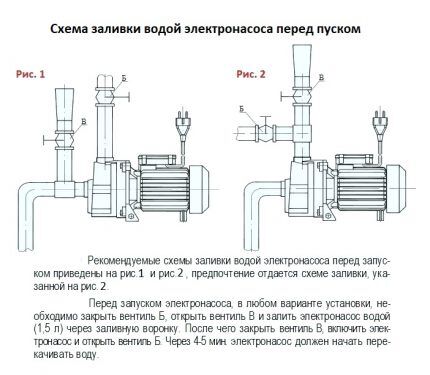




I have seen many such pumps, and I have one. It works flawlessly for our family throughout the warm season. I extended the cable to reach the depth of the well. Very high quality made. But our winter is harsh and we have to make do with other means. And in the south you can operate the pump all year round.
Agidel pumps are very durable units; they will last a long time if you treat them with care and attention. Like all surface systems, “dry running” is contraindicated for them, as a result of which the seals deteriorate, water gets into the engine, short circuit, major repairs. The seals wear out over time and water begins to leak from the drainage hole. Replacement is a simple process, but requires experience and accuracy. Rubber products are easy to damage, so buy extra and replace both.
From experience I can say that under no circumstances should you start these pumps without first filling them with water.
The impeller on the Agidel M pump was cut off. It is impossible to remove the remains of the impeller from the motor armature axis. Lack of experience is taking its toll. It's a pity there is no video of disassembling the pump.
I've been using it for 15 years. It worked flawlessly. A few days ago the pump stopped pumping out water. Spins empty. There is water in the wells. The seal is new. I thought there was a place where the air was being sucked out. Apparently not. Please tell me what is the reason?
First of all, check the pump on a barrel or bucket of water to see if it will pump. If it leaks, then you need to disassemble and check the tightness of the connections at the inlet; if there is a need, wrap it with tape and tighten everything more tightly. You also need to check the functionality of the check valve and replace it if necessary.
The pump does not supply water because the most important place in the pump is the gap between the impeller and the bottom cover; if there is a large gap there, the pump will not pump.
Submersible fecal pumps operate by spinning the liquid and
At the exit of the volute, a vacuum is created at the pump inlet.
In an Agidel type pump, the liquid is spun up and ejected from the volute, a new portion of water arrives due to the vacuum at the entrance to the impeller and if there is no
the required minimum clearance, the pump will not pump even if the seals are new; this is the most important condition for the operation of the pump.
If the oil seal is faulty, water flows out of the control hole, but if the gap is incorrect, the pump, when checking operation, does not suck well from the bucket and, accordingly, gives little pressure.
So how to treat this pump disease?
1.after disassembling, take the impeller and inspect it carefully
2. Insert it into the lower base; it should fit easily, but the gap should be minimal; the entire operation of the pump depends on it
My gap was 1.2 mm. To eliminate the gap, I used heat shrink with a diameter of 24 mm, put a ring on the impeller and thus eliminated the gap.
You can insert a ring into the body and thus remove the gap.
It is better to use heat shrink; it has an adhesive coating inside; after installing the heat shrink, check for the necessary gap; if the impeller does not fit in or fits in tightly, you must already adjust the housing to it.
This is how in the repair description everyone writes only about the seals, but no one wrote how the pump works
Good luck in the repair, use your brains and move forward, but you need to have brains and patience, and if you don’t have this, you can’t buy it in the store.
They tell me that everyone should mind their own business, to which I answer THEN THE WIFE SHOULD ALSO BE WORKED BY A SPECIALIST and as it happens, a person who has the makings of a mind begins to delve into and try to do something, but those who have no brains continue to say that everyone should mind their own business and when it doesn't do anything
All the best Vladimir I am 70 years old and can already give advice.
I have the same problem. The pump rotates but does not pump water. Even from a bucket
what is the reason? I installed a new seal.
Oleg, there is a plug on the pump - (like a plastic bolt), unscrew it and air will come out of the pump.